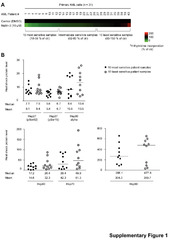| dc.description.abstract | Background: The small-molecule MDM2 antagonist nutlin-3 has proved to be an effective p53 activating therapeutic compound in several preclinical cancer models, including acute myeloid leukemia (AML). We and others have previously reported a vigorous acetylation of the p53 protein by nutlin-treatment. In this study we aimed to investigate the functional role of this p53 acetylation in nutlin-sensitivity, and further to explore if nutlin-induced protein acetylation in general could indicate novel targets for the enhancement of nutlin-based therapy. Results: Nutlin-3 was found to enhance the acetylation of p53 in the human AML cell line MOLM-13 (wild type TP53) and in TP53 null cells transfected with wild type p53 cDNA. Stable isotope labeling with amino acids in cell culture (SILAC) in combination with immunoprecipitation using an anti-acetyl-lysine antibody and mass spectrometry analysis identified increased levels of acetylated Histone H2B, Hsp27 and Hsp90 in MOLM-13 cells after nutlin-treatment, accompanied by downregulation of total levels of Hsp27 and Hsp90. Intrac ellular levels of heat shock proteins Hsp27, Hsp40, Hsp60, Hsp70 and Hsp90α were correlated to nutlin-sensitivity for primary AML cells (n = 40), and AML patient samples with low sensitivity to nutlin-3 tended to express higher levels of heat shock proteins than more responsive samples. Combination therapy of nutlin-3 and Hsp90 inhibitor geldanamycin demonstrated synergistic induction of apoptosis in AML cell lines and primary AML cells. Finally, TP53 null cells transfected with a p53 acetylation defective mutant demonstrated decreased heat shock protein acetylation and sensitivity to nutlin-3 compared to wild type p53 expressing cells. Conclusions: Altogether, our results demonstrate that nutlin-3 induces acetylation of p53, histones and heat shock proteins, and indicate that p53 acetylation status and the levels of heat shock proteins may participate in modulation of nutlin-3 sensitivity in AML. | en_US |




